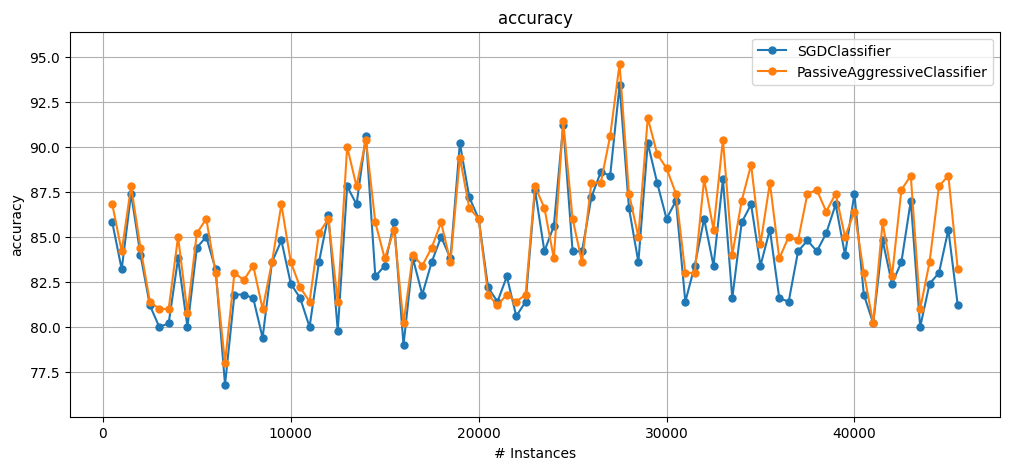2. Using sklearn with CapyMOA#
In this tutorial we demonstrate how someone can directly use scikit-learn learners in CapyMOA.
The primary requirement for a scikit-learn learner to be used is that it implements
partial_fit().
More information about CapyMOA can be found at https://www.capymoa.org.
last update on 28/11/2025
2.1 Using raw sklearn objects#
This example shows a model from scikit-learn can be used with our
Instancerepresentation in a simple test-then-train loop.In this case, we need to adapt data to accommodate what the sklearn expects.
[2]:
from capymoa.evaluation import ClassificationEvaluator
from capymoa.datasets import ElectricityTiny
from sklearn import linear_model
# Toy dataset with only 1000 instances
elec_stream = ElectricityTiny()
# Creates a sklearn classifier
sklearn_SGD = linear_model.SGDClassifier()
ob_evaluator = ClassificationEvaluator(schema=elec_stream.get_schema())
# Counter for partial fits
partial_fit_count = 0
while elec_stream.has_more_instances():
instance = elec_stream.next_instance()
prediction = -1
if (
partial_fit_count > 0
): # scikit-learn does not allow invoking predict in a model that has not been previously fitted
prediction = sklearn_SGD.predict([instance.x])[0]
ob_evaluator.update(instance.y_index, prediction)
sklearn_SGD.partial_fit(
[instance.x], [instance.y_index], classes=elec_stream.schema.get_label_indexes()
)
partial_fit_count += 1
ob_evaluator.accuracy()
[2]:
84.7
2.2 Using a generic SKClassifier wrapper#
Instead of sklearn’s
SGDClassifierhere we use the CapyMOA wrapperSKClassifieron a test-then-train loop.There is also a
SKRegressoravailable in CapyMOA.
[3]:
from sklearn import linear_model
from capymoa.base import SKClassifier
from capymoa.evaluation import ClassificationEvaluator
## Opening a file as a stream
elec_stream = ElectricityTiny()
# Creating a learner
sklearn_SGD = SKClassifier(
schema=elec_stream.get_schema(), sklearner=linear_model.SGDClassifier()
)
# Creating the evaluator
sklearn_SGD_evaluator = ClassificationEvaluator(schema=elec_stream.get_schema())
while elec_stream.has_more_instances():
instance = elec_stream.next_instance()
prediction = sklearn_SGD.predict(instance)
sklearn_SGD_evaluator.update(instance.y_index, prediction)
sklearn_SGD.train(instance)
sklearn_SGD_evaluator.accuracy()
[3]:
84.7
2.3 Using prequential evaluation and SKClassifier#
Instead of an instance loop we may use the
prequential_evaluation()function.
[4]:
from capymoa.evaluation import prequential_evaluation
elec_stream = ElectricityTiny()
sklearn_SGD = SKClassifier(
schema=elec_stream.get_schema(), sklearner=linear_model.SGDClassifier()
)
results_sklearn_SGD = prequential_evaluation(
stream=elec_stream, learner=sklearn_SGD, window_size=4500
)
results_sklearn_SGD.cumulative.accuracy()
[4]:
84.7
2.4 Further abstractions#
We can wrap popular algorithms to make then even easier to use.
So far, one can use the following wrappers:
PassiveAggressiveClassifierSGDClassifierPassiveAggressiveRegressorSGDRegressor
In the following example we show how one can use
SGDClassifierandPassiveAggressiveClassifier.
[5]:
%%time
from capymoa.classifier import SGDClassifier, PassiveAggressiveClassifier
from capymoa.evaluation import prequential_evaluation_multiple_learners
from capymoa.evaluation.visualization import plot_windowed_results
from capymoa.datasets import Electricity
stream = Electricity()
sklearn_SGD = SGDClassifier(schema=stream.get_schema())
sklearn_PA = PassiveAggressiveClassifier(schema=stream.get_schema())
results = prequential_evaluation_multiple_learners(
stream=stream, learners={"SGD": sklearn_SGD, "PA": sklearn_PA}, window_size=500
)
plot_windowed_results(results["SGD"], results["PA"], metric="accuracy")
CPU times: user 53.8 s, sys: 97.9 ms, total: 53.9 s
Wall time: 53.7 s
